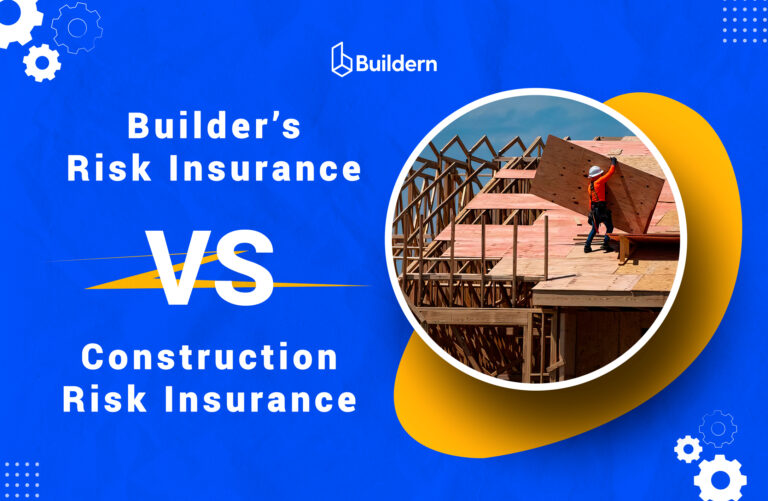End-to-End Guide: PO Invoice Processing in Buildern
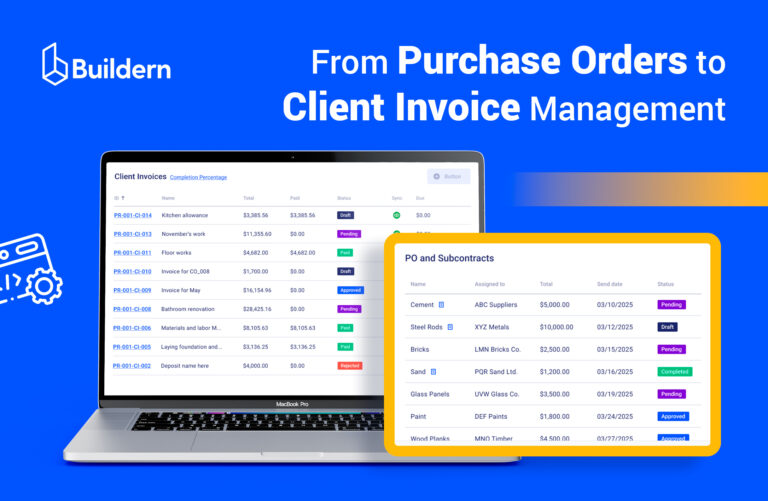
Over the years of working with construction teams, I’ve noticed one recurring pain point: purchase orders (POs) and client invoices never move as smoothly as we’d like them to.
Some invoices are issued late, while others don’t match the original PO. Sometimes, we may even lose track of commitments made in the field versus what’s recorded in the office.
As a result, I’ve grown to see PO invoice processing as more than just paperwork. It’s the financial base keeping our projects predictable and relationships with clients and vendors stable. In my guide, I’ll walk you through the full PO invoice workflow, sharing the practices that helped us and hacks on how Buildern simplifies the process.
Table of Contents
- Understanding Purchase Orders and Invoices in Construction
- How POs and Invoices Connect
- Common Challenges in PO Invoice Processing
- Step-by-Step: PO Invoice Processing in Buildern
- Best Practices My Team Implements for Smooth PO Invoice Processing

Understanding Purchase Orders and Invoices in Construction
On most jobs we’ve managed, purchase orders are the first line of control. A PO is the written agreement between builders and the vendors. It spells out what was ordered, who is supplying it, quantities, unit cost, cost codes, and when it’s needed. That single sheet gives everyone a shared reference before money is spent. Without it, tracking quickly turns messy.
Invoices come later. They arrive as construction bills once the vendor has delivered or finished the work, and we are ready to issue invoices to our clients.
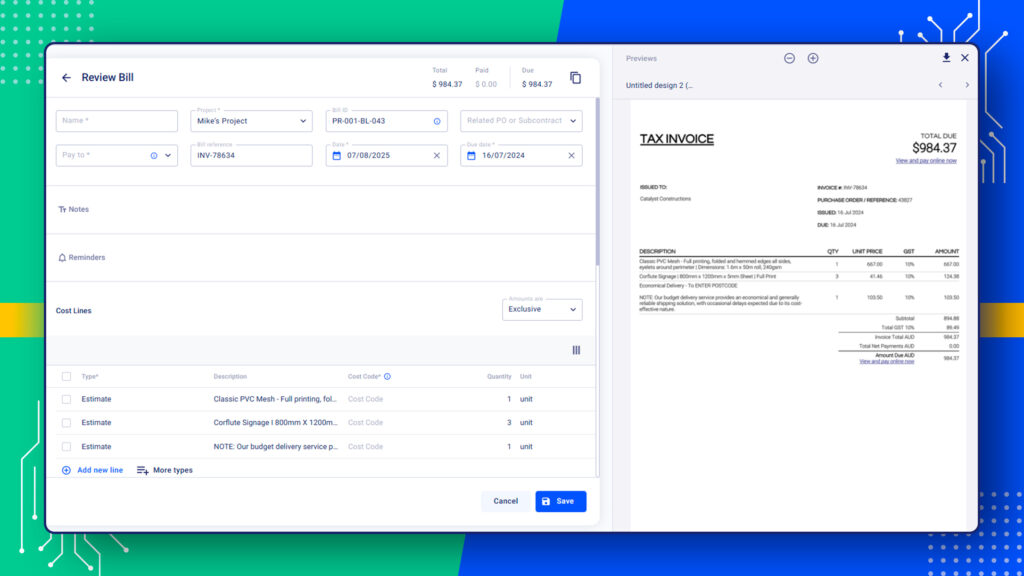
It’s our formal request for payment. Invoices are the proof that what was promised has actually been completed. They also feed directly into the financial side of the project, ensuring budgets line up with reality.
💡POs authorize spending, and invoices confirm it happened.
How POs and Invoices Connect
These two documents only work well when tied together. It’s also called a three-way match, when the PO, the invoice, and the contract must all show the same numbers. Quite recently, we’ve seen how powerful this simple check is. If the invoice doesn’t match the PO, payment is held until it’s sorted. That prevents overbilling and accidental duplicate payments.
In practice, it has saved us many times. One vendor once submitted the same bill twice when payment felt slow. Because it was matched against the original PO, our digital project management system flagged it instantly. No awkward double payment, no chasing money later. Linking POs, bills, and invoices is what keeps trust steady between all parties.
Common Challenges in PO Invoice Processing
I’ve seen how messy PO and invoice workflows can get when they aren’t organized. At first, it looks like simple paperwork. But when things move fast on site, details slip, numbers get mistyped, and communication lags. The mistakes pile up quietly until they hit cash flow. Below are some of the challenges we’ve run into most often.
Manual Data Entry Errors
Typing rows of numbers into spreadsheets is one of the easiest places to go wrong. A single digit off, and suddenly the invoice total doesn’t resemble the PO. We once caught an error where 1,200 pieces were recorded instead of 120. The invoice looked legitimate until we dug into the delivery slip. Fixing that error took weeks of reconciliation. Mistakes like that cost time, and sometimes money too.
Miscommunication Between Field and Office
I can’t count the number of times the office thought paperwork was missing when the field swore it was already handled. Superintendents sometimes confirm deliveries verbally and move on, assuming accounting knows. But the office waits for a signed document that never shows up. The gap holds up approval. It also sparks frustration on both ends, with one side saying “we told you,” the other saying “we have no proof.”
Duplicate or Unmatched Invoices
We’ve had vendors resubmit invoices when payment didn’t arrive as quickly as they expected. Without proper checks, those duplicates could slip through. Other times, an invoice shows up with no PO attached at all. This leaves managers questioning whether the purchase was even authorized. Both situations waste time chasing answers and strain relationships with suppliers.
Cash Flow Disruptions Due to Poor Visibility
The toughest challenge has been poor visibility. When POs, invoices, and budgets aren’t lined up in one place, cash flow planning turns into constant guesswork. We’ve been in situations where approved commitments were already beyond the available budget, and no one realized until payments came due. The result is scrambling for funds, delaying payments, and unnecessary stress across the team.
Step-by-Step: PO Invoice Processing in Buildern
When we first started organizing purchase orders and invoices in separate spreadsheets, the process felt a bit messy. The field had its numbers, accounting had another version, and by the time invoices were ready to send, we were already chasing down missing details. What we really needed was a single, connected flow from the first PO we issued to the final payment received from the client.
Buildern gives that structure to its users. Every stage, from creating purchase orders to generating invoices and tracking payments, is tied back to the project budget. Such a connection means we don’t just move paperwork faster but maintain cost control and transparency at every step.
Below, I’ll walk you through exactly how we manage PO invoice processing inside Buildern. These are the steps we follow on our own projects, and the same ones you can replicate to make sure commitments, invoices, and payments stay accurate and aligned.
Step 1: Creating a Purchase Order
Most of our POs start where the money is planned, not where it is spent. We open the approved estimate or budget, pick the relevant cost code, and generate a PO directly from that line. This keeps scope, quantities, and pricing anchored to the budget structure we already trust.
From there, we assign the vendor or subcontractor, confirm units and unit rates, and capture terms that matter later, like delivery windows, retention, and insurance requirements. If it is a service, we issue a subcontract with the same level of detail so the agreement reflects the real scope, not a vague placeholder.
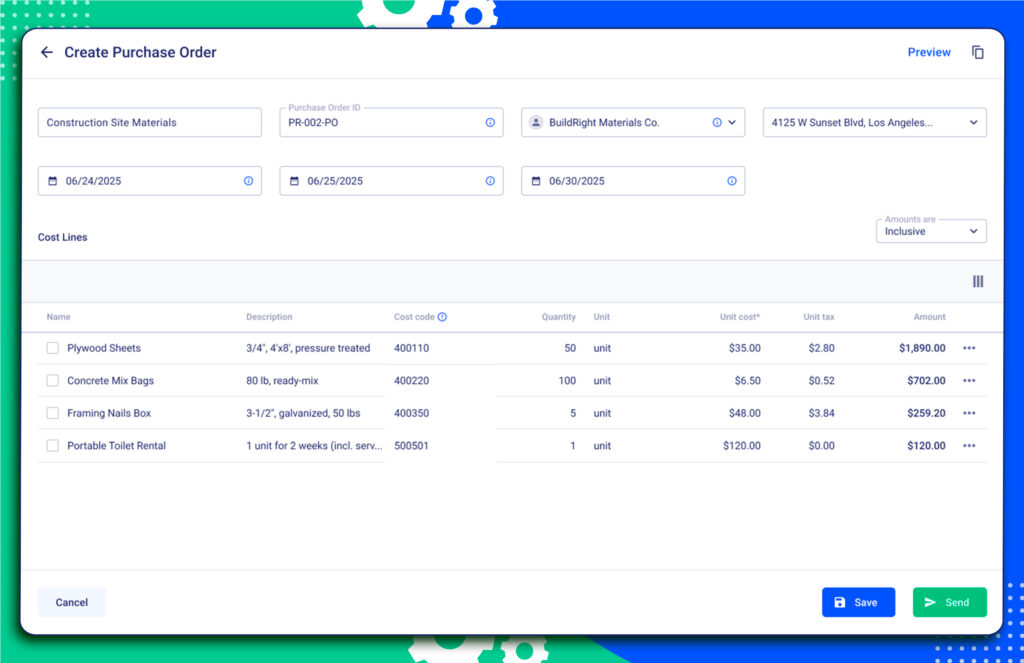
We always send POs digitally. Vendors and subcontractors can view, comment, and acknowledge them in our software, even if they do not have an account. That simple acknowledgment prevents disputes later. Everyone sees the same scope and price before any material ships or labor starts.
Step 2: Tracking PO Status
Once POs are out, we live in the status view. Open, pending approval, approved, or completed tells us exactly where commitments stand. Buildern rolls those commitments into the project’s cost view, so we can see, at a glance, how much is committed versus how much has actually hit the job.
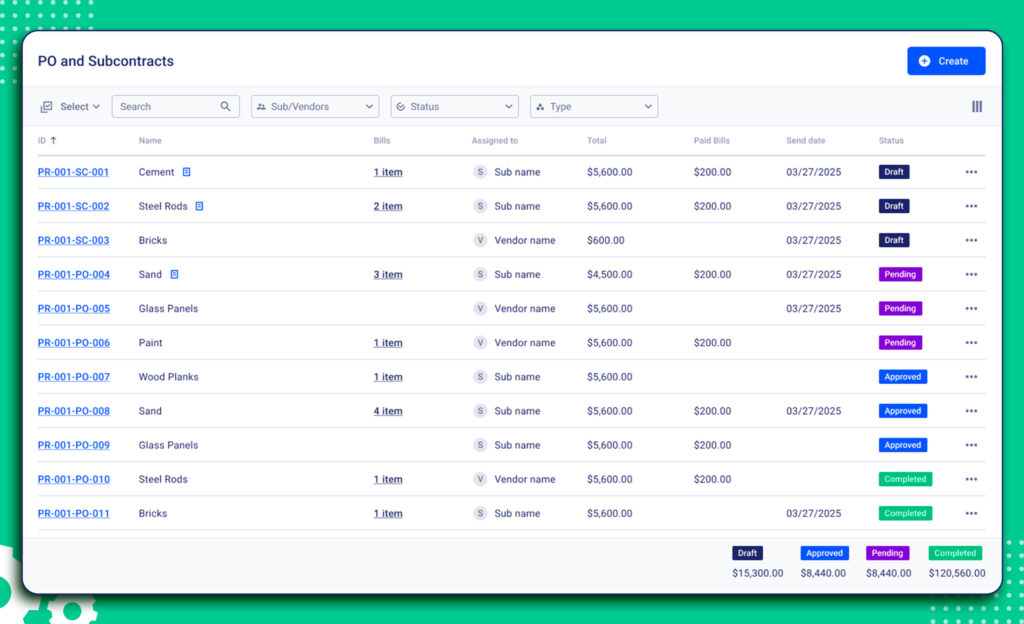
When a PO changes status or an approval is waiting on someone, the right people get notified. Such flexibility keeps us from discovering surprises at the end of the month. It also feeds our forecasting. If commitments are climbing faster than planned, we know it before it becomes a cash crunch.
Step 3: Issuing a Client Invoice
We create client invoices as soon as the scope is delivered or a milestone is reached. In fixed-price work, we invoice by schedule of values or milestone, while in cost-plus jobs, we pull the approved costs and fees.
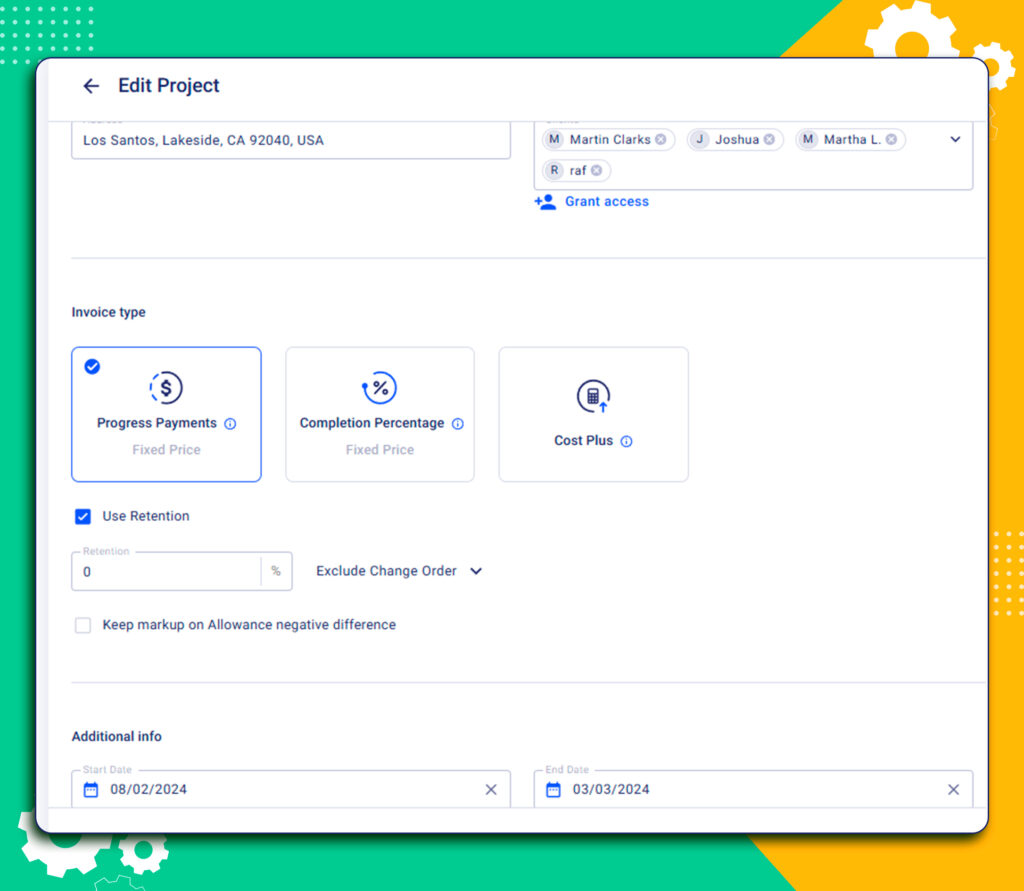
In practice, we start by selecting the project and choosing the invoice method. Our construction PM software lets us convert approved estimates and change orders straight into an invoice, which removes manual entry and the errors that come with it.
Moreover, if the owner requires industry formats, we generate G702 and G703 with the right level of detail. For construction SOV billing, line items flow from the contract breakdown we agreed on at award.
We brand the invoice with our logo and template, add notes clients actually read, and save drafts until internal numbers are final. When it is ready, we send it from Buildern, so delivery, opens, and payment status are tracked without email guesswork.
Step 4: Reconciling Costs Against POs Before Billing
Before we send a cost-plus invoice, we reconcile what the job consumed against the POs and subcontracts authorizing the spend. Buildern helps us line up quantities, prices, and cost codes so the client sees clean, defensible numbers.
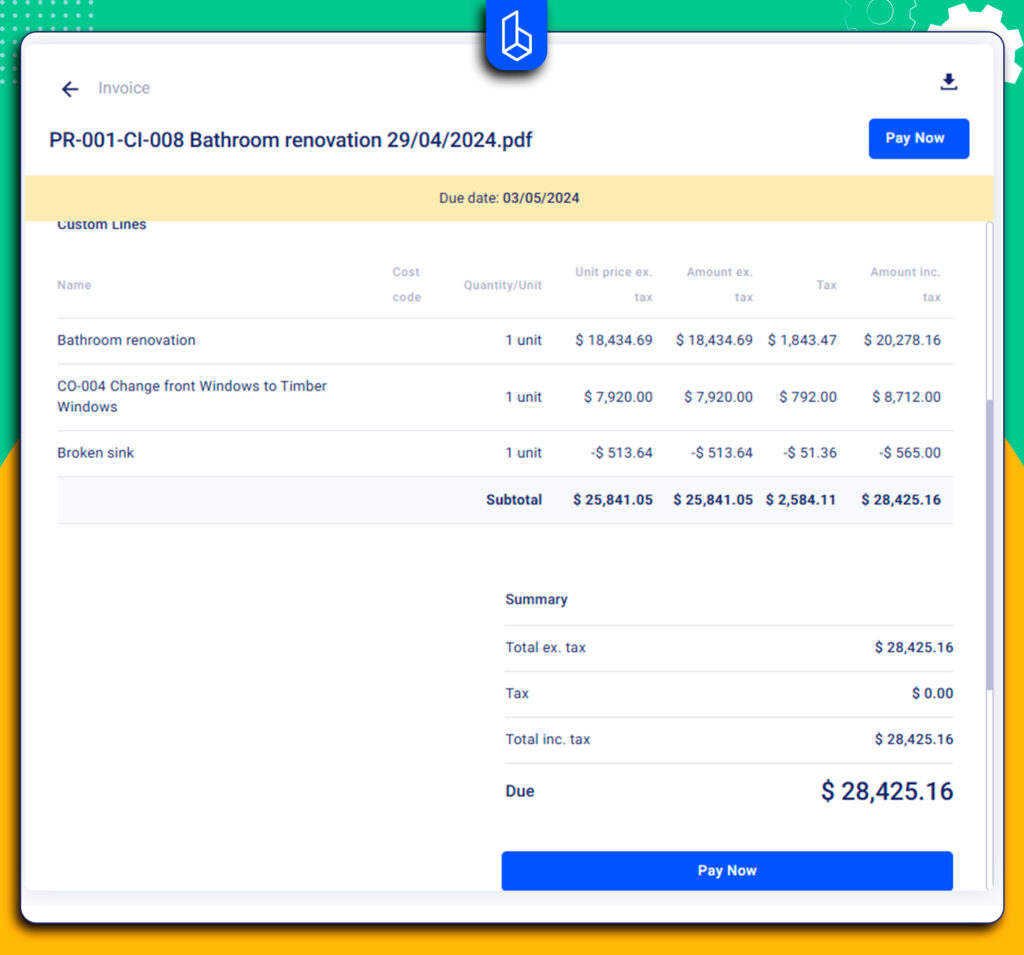
If anything does not match the approved PO, the discrepancy is flagged for review. Sometimes we split a cost across multiple POs or cost codes when it serves more than one scope. Other times, we correct a unit rate or quantity that came in off by a digit. Thus, overpayments are prevented, and owner trust is earned. By the time the client sees the invoice, it reflects approved commitments tied to actual delivery.
Step 5: Approving the Invoice
No invoice goes out without approvals. We route invoices through a workflow mirroring how our team works: project managers review scope and progress, accounting checks numbers and tax, and executives approve releases above a set threshold.
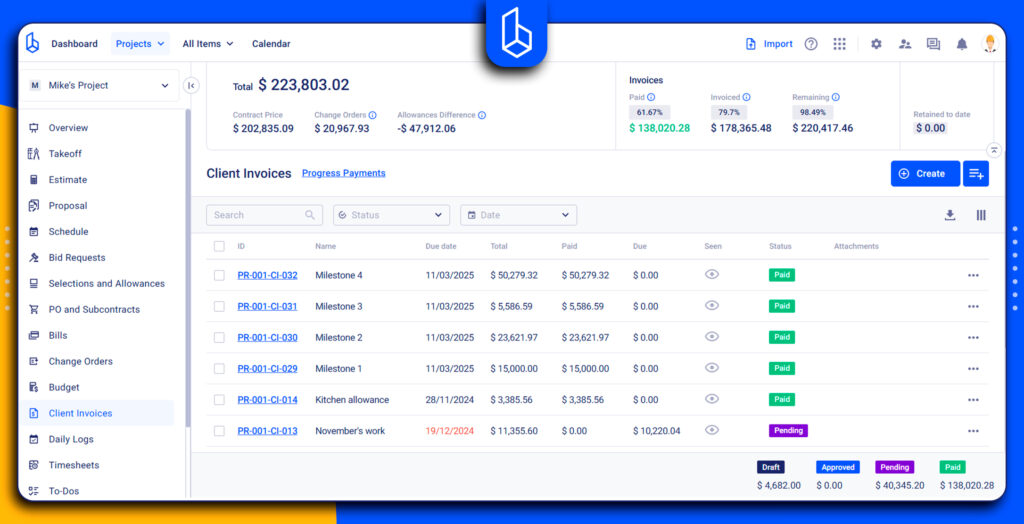
Buildern uses role-based permissions so reviewers only see and act on what they own. Automated reminders nudge the process along when someone is holding a step. We have learned how this discipline speeds things up, not slows them down, because questions are answered before an invoice leaves our hands.
Step 6: Recording Payments and Staying on Top of Collections
After the invoice is delivered, tracking payments is part of the same flow. We record payments in Buildern, including partial payments and retainage, so aging and cash position are always current. If the client pays online, we see it immediately. If they prefer ACH or card, those options are available and reduce delays.
Collections are no longer a separate spreadsheet. Automated reminders go out for upcoming due dates and overdue balances. We get alerts when a client views an invoice or makes a payment, which helps us follow up at the right time with the right message. As payments land, the project’s actuals update and roll into cash flow and budget reports, so forecasting reflects reality, not assumptions.
✅ Mini-Checklist: How We Process POs and Invoices in Buildern
| Step | What You Can Do |
|---|---|
| Create PO | Open the budget → select cost code → New PO → add vendor/sub details → confirm quantities, rates, and terms → send for acknowledgment. |
| Track PO Status | Go to PO dashboard → filter by status (Open / Pending / Approved / Completed) → set up notifications for pending approvals. |
| Issue Client Invoice | From project view → Create Invoice → choose type (fixed-price, cost-plus, SOV, G702/703) → auto-pull approved estimate or change order → apply template → send to client. |
| Reconcile Costs | Review invoice items → match against POs and subcontracts → resolve discrepancies → split across codes if needed. |
| Approval Workflow | Route invoice → project manager review → accounting check → exec sign-off if above threshold → Buildern auto-sends reminders. |
| Record Payment | Open invoice → Add Payment → log partial/full/retainage → track status in real time → updates flow into budget and cash flow reports. |
Best Practices My Team Implements for Smooth PO Invoice Processing
Through trial and error, we’ve learned PO invoice processing only runs smoothly when the team follows consistent practices. It’s not enough to have the right tools and habits, as discipline matters just as much.
Here are the steps we’ve built into our workflow to keep things under control and prevent last-minute surprises.
Always Initiate Purchases with a PO, Not a Direct Invoice
We’ve stopped accepting invoices without a PO behind them. A PO makes sure the purchase is authorized before it ever reaches accounting. Without that, we risk paying for items no one approved.
I remember one case where a vendor delivered equipment straight to the site and sent an invoice later with no PO, no prior discussion. Sorting this out took weeks and strained the relationship. Requiring POs first keeps everyone honest and saves the project team from backtracking.
Set Clear Approval Hierarchies in the System
Approvals can get stuck if no one knows who has the authority to sign off. In our system, we’ve set clear levels for site managers to handle smaller purchases, while bigger commitments go up to project executives. This structure prevents delays and stops people from guessing who should decide.
Train Project Teams to Link Documents Consistently
One of the biggest improvements we made was training teams to always connect invoices back to the matching POs. It sounds obvious, but without training, people upload files in different places or forget to add references. When everything is linked, you can trace the story from order to payment in seconds.
Consistency has saved us countless hours during audits and closeouts. Training doesn’t take long, but the payoff is huge.
Use Dashboards for Proactive Cash Flow Management
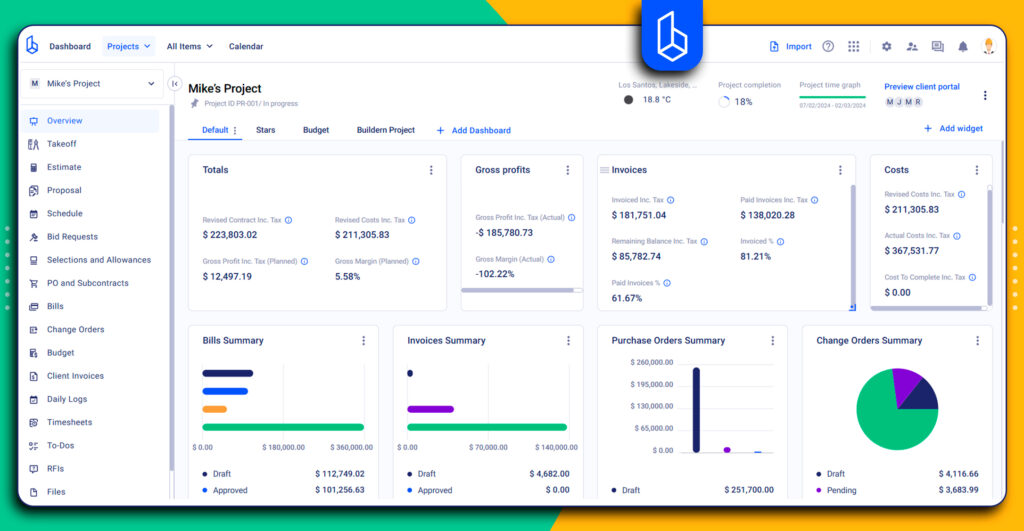
Dashboards have changed the way we manage money across projects. Instead of checking separate spreadsheets and folders, we see all commitments and invoices in one place.
In Buildern, we’ve customized dashboards to pull POs, invoices, and budget data together. Such a view makes it easier to spot when spending is running ahead of schedule.
Key Ideas
- POs set the foundation: They define scope, costs, and terms upfront, giving both the builder and vendors a shared reference before money is spent.
- Invoices complete the cycle: By linking invoices to POs and contracts, we create a clear financial trail that prevents errors, disputes, and overbilling.
- Challenges can be avoided: Issues like data entry mistakes, miscommunication, duplicates, and cash flow surprises disappear when the process is centralized.
- Buildern connects it all: From issuing POs and tracking their status to generating client invoices, approving them, and recording payments, every step stays tied to the project budget and cash flow in real time.

What Is the Difference Between a PO and an Invoice?
A purchase order (PO) is created by the buyer before any goods or services are delivered. It spells out what is being ordered, the quantities, agreed prices, and delivery terms. This document is the project’s commitment; it shows intent and gives vendors the green light to move forward.
An invoice comes after. Vendors issue bills once materials arrive or services are completed. It is the request for payment, confirming the work has been done as agreed. Then we are ready to send out invoices to our clients. While they serve different purposes, both POs and invoices carry common details like item descriptions, amounts, dates, and payment terms.
Can Invoices Be Processed Without a PO? (Non-Po Invoices)
Yes, it happens, but only in specific cases. We’ve seen it used for things like emergency purchases, utilities, recurring subscriptions, or small expenses that were already pre-approved. In these scenarios, a full PO process might not be practical.
How Does Buildern Handle Partial Invoices?
With Buildern, we handle partial invoices by breaking them down directly against the contract or schedule of values. When we create the invoice, we can mark specific line items as partially billed and leave the remaining balance open for the next billing cycle. The system automatically keeps track of what’s been invoiced, what’s outstanding, and what’s held back as retainage.
This way, our clients see a clean breakdown: how much work has been completed, how much has been paid, and what’s left. On our side, we get real-time updates in the budget and cash flow reports. Visibility helps us forecast cash flow more accurately and avoid confusion down the road.

![Detailed Construction Project Cost Breakdown [Examples Included]](https://buildern.com/resources/wp-content/uploads/2024/09/BLOG_Cover_Construction-project-cost-breakdown-2-copy-768x501.webp)
